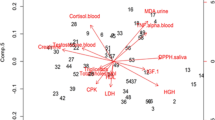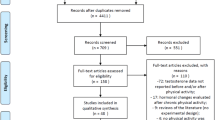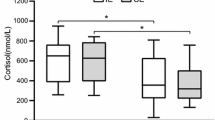Abstract
This study was performed to assess how 4 weeks of magnesium supplementation and exercise affect the free and total plasma testosterone levels of sportsmen practicing tae kwon do and sedentary controls at rest and after exhaustion. The testosterone levels were determined at four different periods: resting before supplementation, exhaustion before supplementation, resting after supplementation, and exhaustion after supplementation in three study groups, which are as follows: Group 1—sedentary controls supplemented with 10 mg magnesium per kilogram body weight. Group 2—tae kwon do athletes practicing 90–120 min/day supplemented with 10 mg magnesium per kilogram body weight. Group 3—tae kwon do athletes practicing 90–120 min/day receiving no magnesium supplements. The free plasma testosterone levels increased at exhaustion before and after supplementation compared to resting levels. Exercise also increased testosterone levels relative to sedentary subjects. Similar increases were observed for total testosterone. Our results show that supplementation with magnesium increases free and total testosterone values in sedentary and in athletes. The increases are higher in those who exercise than in sedentary individuals.
Similar content being viewed by others
Avoid common mistakes on your manuscript.
Introduction
Physical stress from hard exercise has a definitive effect on homeostasis. The autonomous nervous system and the hypothalamus–pituitary–adrenal axis react to protect physical integrity by restoring homeostasis [1].
The physiologic and psychological systems work concurrently during exercise determining energy intake. Leptin and cytokines that are secreted from fatty tissues causes changes in cortisone, thyroid, and growth hormone levels [2, 3].
From a large number of studies exploring the relationship between exercise and hormones, no definite conclusion can be drawn [4–6]. Short-term strenuous exercise increased total and free testosterone levels by 12% and 13%, respectively [7]. Exercise led to increases in free and total testosterone levels in young and old subjects [8]. On the contrary, acute heavy resistance exercise reduced total and free testosterone values in 21-year-old individuals due to decreases in LH production [9]. In another study, weight lifting had no effect on testosterone levels [10].
Magnesium is an important cofactor for many enzymes, required in several biochemical events and for energy metabolism [11, 12]. It has been suggested that there is a positive correlation between magnesium levels and physical performance [13, 14]. Through high-energy diets, athletes usually receive sufficient essential minerals including magnesium. This is not the case of subjects under a diet restricted or reduced to maintain or limit their body weight, which might be a cause of insufficient magnesium intake, leading to decreases of physical performance [15, 16].
A look at the relevant literature indicates that different types of training have different effects on testosterone levels. Nevertheless, there are not many studies on the combined effects of magnesium supplementation and exercise on testosterone levels.
This study was performed to assess how 4 weeks of magnesium supplementation and exercise influence the free and total plasma testosterone levels at rest and after exhaustion in sportsmen and sedentary controls.
Materials and Methods
Subjects
Thirty healthy male subjects of ages between 18 and 22 years voluntarily participated in the study. Before the start of the research protocol, all the participants gave their consent for participation after the purpose of the study was explained to them. The participants were divided into three groups of ten subjects each, kept under distinct regimes for 4 weeks as follows:
-
Group 1: Sedentary subjects receiving 10 mg magnesium (as MgSO4) per kilogram body weight per day.
-
Group 2: The subjects received the magnesium supplement while practicing tae kwon do routines for 90–120 min per day, 5 days a week.
-
Group 3: Subjects training as those in group 2, but without magnesium supplement.
Blood samples were drawn from all participants before and after the experimental period at rest and after exhaustion. Serum free and total testosterone values were determined by standard clinical laboratory procedures.
Exhaustion Measurements
To achieve exhaustion, the participants underwent a 20-m shuttle run test prior to blood sampling. The test was applied at the Training and Sports Academy, Selcuk University. The test starts with a slow running speed (8 km h−1) in which the subject runs in a 20-m track following a signal. The subject should run to the end of the track and touch the finish line with one foot before the signal to return sounds again. The subject is allowed to continue the test if one signal is missed, but dismissed if he has difficulty in following the signal or if he or she is 3 m short of the finish line consecutively in two cycles. At this point, the running speed is increased 0.5 m/min. Each minute counts as a grade point. The result of the test is the number of accumulated points, which is taken as indicator of endurance. The duration of the test depends on the individual’s ability and strength [17].
Analyses of Hormones
Blood samples (2 ml) were drawn into EDTA tubes and used to determine the testosterone levels. Free testosterone (pg/ml; lot no: 05126) was determined by means of a DSL RIA kit on gamma counter. Total testosterone (ng/dl) was determined by Acces Immunoassay system test kit and Unicel DXI 800 photoanalyser (lot no: 612500).
Statistical Analysis
The statistical analysis was performed with the SPSS statistical program. The results are expressed as means ± SD. The Kruskal–Wallis analysis of variance was used for comparison between groups, and the Mann–Whitney U test was applied to those with p < 0.05.
Results
The free testosterone levels in groups 1–3 are shown on Table 1. There are no differences between these groups at rest at the beginning of supplementation (Rbs).
Exhaustion values before supplementation increased in all groups compared to rest values; there was no difference between groups (Ebs).
Comparison among groups shows that exhaustion values before supplementation were significantly higher than rest values (p < 0.05). In the after-supplementation values, the highest levels were in group 2 Ras (p < 0.05). The postsupplementation Ras value was higher in group 3 than in group 1. Similar increases were also observed exhaustion after supplementation (Eas) values with group 2 reaching the highest level (p < 0.05).
When Rbs and Ras values were compared, both exercise and supplementation led to significant increases in free testosterone values (p < 0.05).
Table 2 shows the total testosterone levels of the three study groups. No differences are seen at the start of the experiment. Total testosterone increased by exhaustion, with group 2 showing the highest increase (p < 0.05).
The Ras values were higher in the two exercising groups than in the sedentary supplemented controls (p < 0.05). The Eas levels of groups 2 and 3 were higher than those of group 1 (p < 0.05). The Eas values were significantly higher than at Ebs (p < 0.05).
Discussion
The highest level of testosterone is seen in group 2 subjects, who both exercised and received magnesium supplementation. Their Rbs and Ras are significantly different (p < 0.05). A similar increase was found in group 3 subjects, who only trained but received no supplements.
Increases were also observed after supplementation at exhaustion, with group 2 having the highest value (p < 0.05). Total testosterone levels also increased with exhaustion and the highest increase was seen in group 2.
Exercise substantially disrupts homeostasis by physical stress. The hypothalamus–pituitary–adrenal and gonadal axes react to this stress and thus contribute to the preservation of homeostasis and the improvement of physical fitness [18].
Magnesium is needed by the body at a certain level for good health and for maintaining physiological functions. Optimal energy metabolism and work performance depends on certain amounts of magnesium [14].
Still, findings suggesting that magnesium (Mg) enhances performance are controversial [19]. During exercise, physiological and psychological systems cooperatively determine energy need. At the same time, leptin and cytokines secreted from fat tissues affect the levels of cortisone, testosterone, thyroid, and growth hormones [2, 3]. In various studies investigating the relationship between exercise and hormones, different results were obtained [4–6].
Basal and free testosterone levels were found to be lower in cyclists than in weightlifters and a control group [20]. It was postulated that long-term cycling changes anabolic hormone levels. Another study reported that a 2-week heavy training caused a slight increase in testosterone levels [1].
In the present study, 4 weeks training and magnesium supplementation increased both free and total testosterone levels, in good agreement with the findings given above. In addition, the fact that magnesium supplements increase testosterone levels suggests the possibility that it could have a performance-enhancing effect.
Current literature reports focus on short- and long-term testosterone response to various exercise types [2, 21]. Testosterone supplementation increased physical performance and strain by reducing fat density and increasing the amount of muscle [22]. Other studies suggest that the body’s response to exercise may result from a disruption of the hypothalamus and pituitary functions in heavy, short-term exercise [23].
Similarly, severe resistance exercise reduced free and total testosterone levels as a result of a decrease in the amount of LH [24]. It was hard to find studies investigating the effects of Mg supplementation and exercise on testosterone levels. Studies on the effects of Mg supplementation on plasma levels of hormones usually focused on its effect on the response to aging or to a variety of stress factors [25, 26].
Conclusions
The effects of exercise and magnesium supplementation on free and total testosterone levels in tae kwon do athletes and sedentary subjects are reported in this study. The results show that strenuous exercise increases testosterone levels in sedentary and practicing tae kwon do athletes. The plasma testosterone levels are higher in exercising and magnesium supplemented subjects than in sedentary controls, suggesting that magnesium supplementation increases performance by increasing plasma testosterone.
References
Mastorakos G, Pavlatou M (2005) Exercise as a stress model and the interplay between the hypothalamus-pituitary-adrenal and the hypothalamus-pituitary-thyroid axes. Horm Metab Res 37:577–584
Mc Murray RG, Hackney AC (2005) Interactions of metabolic hormones, adipose tissue and exercise. Sports Med 35:393–412
Hackney AC, McMurray RG, Judelson DA, Harrell JS (2003) Relationship between caloric intake, body composition, and physical activity to leptin, thyroid hormones, and cortisol in adolescents. Jpn J Physiol 53:475–479
Duma E, Orbai P, Derevenco P (1998) Blood levels of some electrolytes and hormones during exercise in athletes. Rom J Physiol 35:55–60
Huang WS, Yu MD, Lee MS, Cheng CY, Yang SP, Chin HM, Wu SY (2004) Effect of treadmill exercise on circulating thyroid hormone measurements. Med Princ Pract 13:15–19
Rosolowska-Huszcz D (1998) The effect of exercise training intensity on thyroid activity at rest. J Physiol Pharmacol 49:457–466
Bosco C, Tihanyl J, Rivalta L, Parlato G, Tranquilli C, Pulvirenti G, Foti C, Viru M, Viru A (1996) Hormonal responses in strenuous jumping effort. Jpn J Physiol 46:93–98
Kraemer WJ, Hakkinen K, Newton RU, Nindl BC, Volek JS, McCormick M, Gotshalk LA, Gordon SE, Fleck SJ, Campbell WW, Putukian M, Evans WJ (1999) Effects of heavy-resistance training on hormonal response patterns in younger vs. older men. J Appl Physiol 87:982–992
Kraemer WJ, Staron RS, Hagerman FC, Hikida RS, Fry AC, Gordon SE, Nindl BC, Gothshalk LA, Volek JS, Marx JO, Newton RU, Hakkinen K (1998) The effects of short-term resistance training on endocrine function in men and women. Eur J Appl Physiol Occup Physiol 78:69–76
Guezennec Y, Leger L, Lhoste F, Aymonod M, Pesquies PC (1986) Hormone and metabolite response to weight-lifting training sessions. Int J Sports Med 7:100–105
Lukaski HC, Bolonchuk WW, Kelvay L, Milne DB, Sandstead HH (1983) Maximal oxygen consumption as related to magnesium, copper and zinc nutriture. Am J Clin Nutr 37:407–415
Lukaski HC, Nielsen FH (2002) Dietary magnesium depletion affects metabolic responses during sub maximal exercise in postmenopausal women. J Nutr 132:930–935
Bohl CH, Volpe SL (2002) Magnesium and exercise. Crit Rev Food Sci Nutr 42:533–563
Golf SW, Bender S, Gruttner J (1998) On the significance of magnesium in extreme physical stress. Cardiovasc Drugs Ther 12:197–202
Keen CL, Lowney P, Gershwin ME, Hurley LS, Stem JS (1987) Dietary magnesium intake influences exercise capacity and hematological parameters in rats. Metabolism 36:788–793
Laires MJ, Madeira F, Sergio J, Colaco C, Vaz C, Felisberto GM, Neto I, Breitenfeld L, Bicho M, Manso C (1993) Preliminary study of the relationship between plasma and erythrocyte magnesium variations and some circulating pro-oxidant and antioxidant indices in a standardized physical effort. Magnes Res 6:233–238
Cinar V, Mogulkoc R, Baltaci AK, Polat Y (2008) Adrenocorticotropic hormone and cortisol levels in athletes and sedentary subjects at rest and exhaustion: effects of magnesium supplementation. Biol Trace Elem Res 121:215–220
Fry AC, Kraemer WJ, Ramsey LT (1998) Pituitary-adrenal-gonadal responses to high-intensity resistance exercise overtraining. J Appl Physiol 85:2352–2359
Clarkson PM (1991) Minerals: exercise performance and supplementation in athletes. J Sports Sci 9:91–116
Izquierdo M, Ibanez J, Hakkinen K, Kraemer WJ, Ruesta M, Gorostiaga EM (2004) Maximal strength and power, muscle mass, endurance and serum hormones in weightlifters and road cyclists. J Sports Sci 22:465–478
Ahtiainen JP, Pakarinen A, Alen M, Kraemer WJ, Hakkinen K (2005) Short vs. long rest period between the sets in hypertrophic resistance training: influence on muscle strength, size, and hormonal adaptations in trained men. J Strength Cond Res 19:572–582
Page ST, Amory JK, Bowman FD, Anawalt BD, Matsumoto AM, Bremner WJ, Tenover JL (2005) Exogenous testosterone (T) alone or with finasteride increases physical performance, grip strength, and lean body mass in older men with low serum T. J Clin Endocrinol Metab 90:1502–1510
Rietjens GJ, Kuipers H, Adam JJ, Saris WH, van Breda E, van Hamont D, Keizer HA (2005) Physiological, biochemical and psychological markers of strenuous training-induced fatigue. Int J Sports Med 26:16–26
Nindl BC, Kraemer WJ, Deaver DR, Peters JL, Marx JO, Heckman JT, Loomis GA (2001) LH secretion and testosterone concentrations are blunted after resistance exercise in men. J Appl Physiol 91:1251–1218
Apple JK, Kegley EB, Maxwell CV Jr, Rakes LK, Galloway D, Wistuba TJ (2005) Effects of dietary magnesium and short-duration transportation on stress response, postmortem muscle metabolism, and meat quality of finishing swine. J Anim Sci 83:1633–1645
Held K, Antonijevic IA, Kunzel H, Uhr M, Wetter TC, Golly IC, Steiger A, Murck H (2002) Oral Mg(2+) supplementation reverses age-related neuroendocrine and sleep EEG changes in humans. Pharmacopsychiatry 35:135–143
Author information
Authors and Affiliations
Corresponding author
Rights and permissions
About this article
Cite this article
Cinar, V., Polat, Y., Baltaci, A.K. et al. Effects of Magnesium Supplementation on Testosterone Levels of Athletes and Sedentary Subjects at Rest and after Exhaustion. Biol Trace Elem Res 140, 18–23 (2011). https://doi.org/10.1007/s12011-010-8676-3
Received:
Accepted:
Published:
Issue Date:
DOI: https://doi.org/10.1007/s12011-010-8676-3




